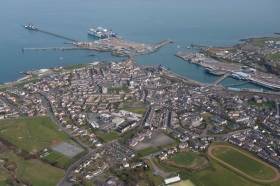Displaying items by tag: Cruise Wales
#CruiseHolyhead - The Port of Holyhead in north Wales will according to Cruise Europe welcome 34% more passengers in 2018 than this year, bringing the total to 36,000 on 43 calls.
The jetty, which is owned by Stena Line but operated by Orthios, presently takes vessels up to 310m in length. However Suzanne Thomas, head of Cruise Wales, told CE that a new multi-use berth development is being considered. It will be 340m long and hence able to accommodate vessels up to 365m in length.
“Royal Caribbean is advising us on the build and the channels and all the technical aspects with regard to the Oasis class. We are hoping it will be ready for 2020. All the stakeholders, including Stena, are still discussing the investment,” she explained.
There is also an anchorage facility which can take any size of vessel. Tenders take four minutes to arrive at the marina in Holyhead.
Every ship is greeted by a choir, a singer or Welsh dancers with many also requesting the entertainment to go on board prior to departure. When a German vessel arrives, ambassadors who speak German are part of the welcome on the jetty, in the shuttles, stationed throughout the town, and take part in Blue Badge tours. When the first call went out 220 Germans living in North Wales applied for the 50 posts. A new training programme to increase numbers is being considered.
In Holyhead cruiseship days are not just for the passengers. Thomas said: “We like to make sure that the local community are involved where possible with the local activities provided. We don’t just have activities on the jetty but a band in the town centre and a local craft market where the booths are provided free for the day. As the passengers come off the ship we give them maps, advice on transport and pamphlets on what is going on, for example three choir performances a day in the church.”
At present there is a project taking place with Royal Caribbean to set up training for hospitality students in a local college. This has already been done with Seabourn whereby the students undertook a couple of contracts at sea and then returned to work on shore with the skills they have learnt.
Fam trips, a cruise conference in 2018 and new tours are all under consideration. The latter are offered direct to the lines rather than to the tour operators. One example is to take the longest zipline in Europe which goes over a quarry.





























































